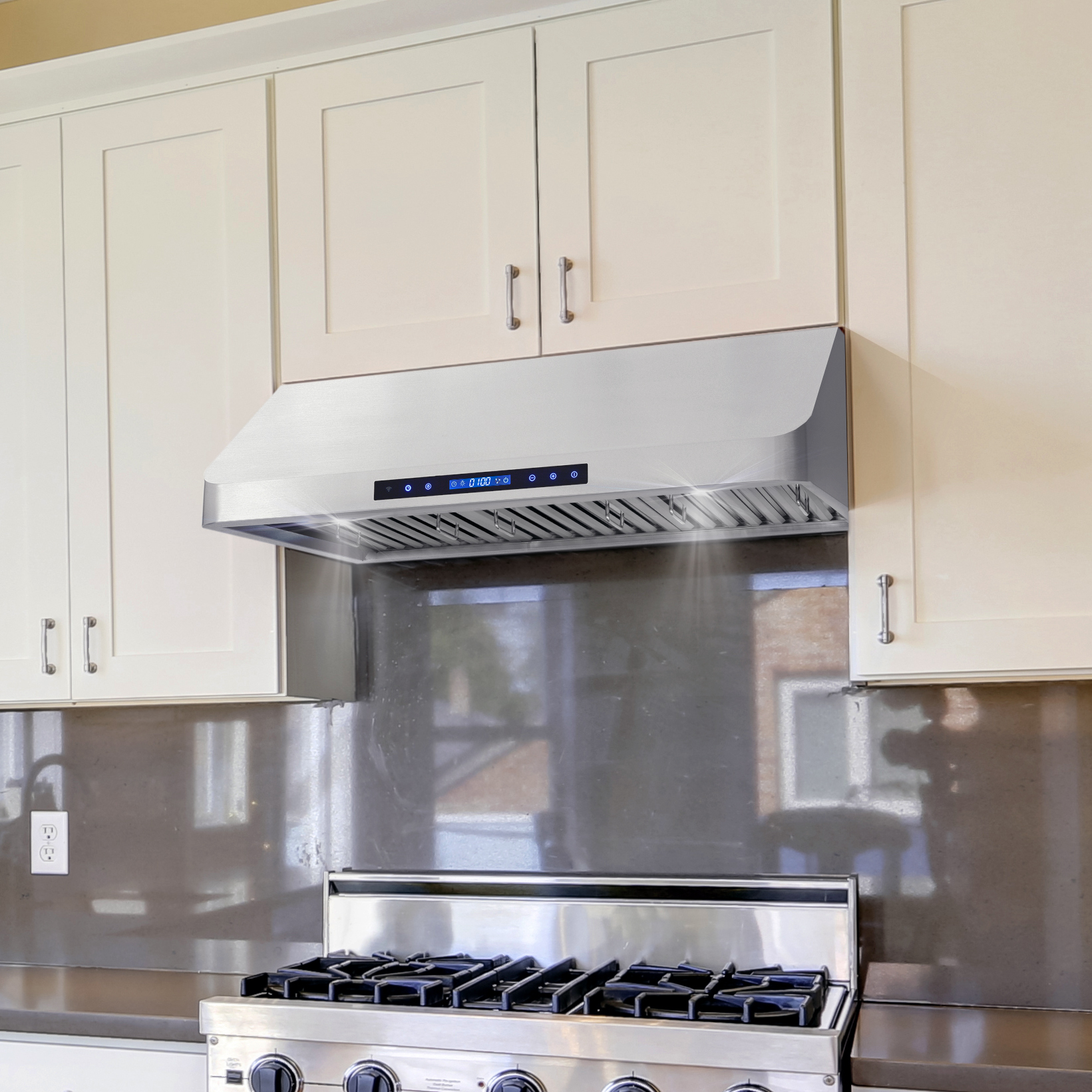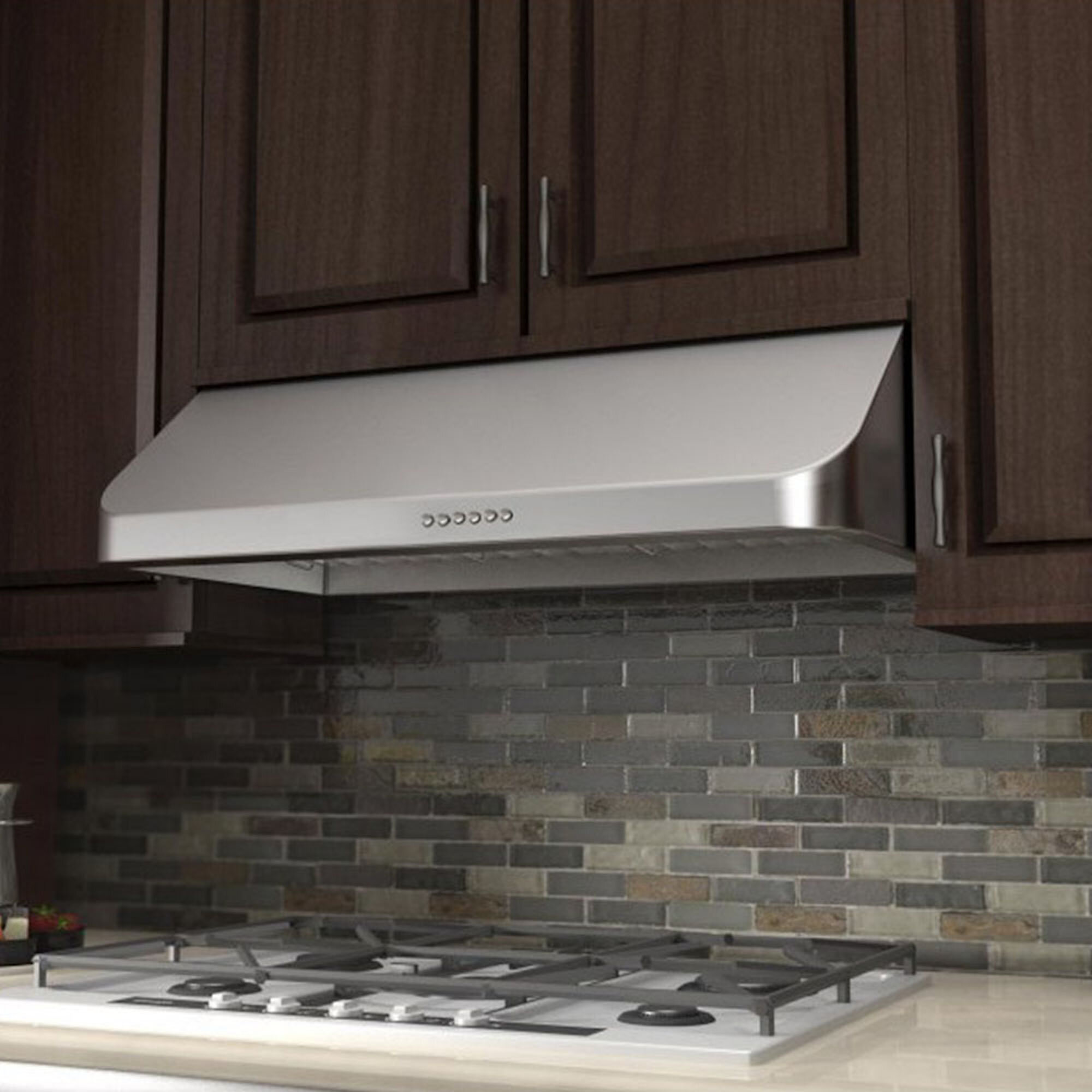Top Features & Considerations for Under Cabinet Range Hoods (Gas Stoves): Best Under Cabinet Range Hoods For Gas Stoves

Choosing the right under-cabinet range hood for your gas stove can feel like navigating a bustling Palembang market – lots of choices, but you need to find the perfect fit! This section will guide you through the essential features and considerations to ensure your kitchen stays fresh and clean, leaving you with more time to enjoy delicious, home-cooked meals.
Under Cabinet Range Hood Comparison
Selecting the right range hood involves careful consideration of several key features. The following table compares five popular models, highlighting their strengths and weaknesses to aid in your decision-making process. Remember, specific models and their features are subject to change, so always check the manufacturer’s website for the most up-to-date information.
| Feature | Model A | Model B | Model C | Model D | Model E |
|---|---|---|---|---|---|
| CFM Rating | 400 CFM | 600 CFM | 500 CFM | 350 CFM | 700 CFM |
| Noise Level (Son) | 65 | 70 | 60 | 55 | 75 |
| Lighting | Halogen | LED | LED | Incandescent | LED |
| Filter Type | Baffle | Charcoal | Mesh | Baffle | Charcoal |
| Installation Method | Ducted | Ductless | Ducted | Ducted | Ductless |
CFM Rating and Gas Stove BTU Output
The CFM (Cubic Feet per Minute) rating of a range hood directly impacts its effectiveness in removing smoke, grease, and odors. Gas stoves have varying BTU (British Thermal Units) outputs, indicating their heat production. A higher BTU output necessitates a higher CFM rating to ensure adequate ventilation. A general guideline suggests a CFM rating of at least 100 CFM for every 10,000 BTU of stove output. For example, a 50,000 BTU gas stove would ideally require a range hood with at least 500 CFM. Insufficient ventilation can lead to a build-up of pollutants and potential safety hazards. It’s crucial to match the CFM rating of your range hood to your stove’s BTU output for optimal performance.
Always refer to your stove’s specifications for its BTU output.
Buyer’s Guide: Key Considerations, Best under cabinet range hoods for gas stoves
Before purchasing an under-cabinet range hood, several factors warrant careful consideration. These include the size of your kitchen, your cooking style (frequent high-heat cooking requires a more powerful hood), your budget, and your aesthetic preferences to ensure seamless integration with your kitchen’s design. Measuring your available space and considering the overall style of your kitchen is paramount to a successful installation.
Range Hood Filter Types
Different filter types offer varying advantages and disadvantages. Charcoal filters absorb odors but don’t filter grease effectively; they require regular replacement. Baffle filters are highly effective at filtering grease and are easier to clean. Mesh filters are less effective at filtering grease but are generally inexpensive and easy to replace. The choice of filter type should align with your cooking habits and maintenance preferences.
Popular Brands and Models

Choosing the right under-cabinet range hood for your gas stove can feel like navigating a bustling Palembang market! There are so many options, each with its own unique features and price point. To help you make the best choice, we’ll delve into some popular brands and models, comparing their strengths, weaknesses, and user experiences. Remember, the “best” hood depends entirely on your specific needs and kitchen setup. Let’s get started!
Best under cabinet range hoods for gas stoves – Selecting a brand depends heavily on your budget and desired features. High-end brands often boast superior performance and quieter operation, but come with a higher price tag. Budget-friendly options are available, but may compromise on some features. Consider your cooking style and frequency when making your decision. A powerful hood is essential for those who frequently cook with high heat or strong-smelling ingredients.
Leading Brands and Their Characteristics
Here’s a quick overview of three leading brands known for their under-cabinet range hoods, highlighting their typical strengths and weaknesses.
- Broan: Known for its wide range of models catering to various budgets and needs. Strengths include generally good performance and readily available parts. Weaknesses can include slightly less sophisticated designs compared to higher-end brands and some models may be noisier than others.
- Bosch: A premium brand offering high-performance hoods with advanced features like quiet operation and sleek designs. Strengths include excellent performance and quiet operation, but weaknesses include a higher price point and potentially less readily available parts compared to Broan.
- Whirlpool: Offers a middle ground between Broan and Bosch, balancing performance with affordability. Strengths include a good balance of price and performance, decent customer support. Weaknesses might include less advanced features compared to Bosch and slightly lower build quality than some competitors.
Comparative Review of Three Models
Let’s compare three specific models from these brands, considering price, performance, and user reviews. Remember that individual experiences can vary, and these are based on aggregated reviews.
| Model | Brand | Price Range (USD) | Performance & User Reviews Summary |
|---|---|---|---|
| Broan 413004 | Broan | $150 – $250 | Generally positive reviews for its affordability and decent performance. Some users report noticeable noise at higher fan speeds. |
| Bosch DWH6555UC | Bosch | $400 – $600 | High praise for quiet operation and powerful suction. Some users find the controls a bit complicated. |
| Whirlpool WRT518SZDM | Whirlpool | $250 – $400 | Mixed reviews, with some users satisfied with the performance and others reporting issues with suction or noise. |
Common User Issues and Solutions
Understanding common issues reported by users can help you make an informed decision and prepare for potential troubleshooting.
- Noise: Many users report increased noise at higher fan speeds. Solution: Consider models with quieter operation (check CFM and decibel ratings) or use lower fan speeds when possible.
- Suction Issues: Insufficient suction can be caused by improper installation or a clogged filter. Solution: Ensure proper installation according to the manufacturer’s instructions and regularly clean or replace the filters.
- Control Panel Issues: Some users report difficulties with the control panel. Solution: Carefully review the user manual, or contact customer support if the issue persists.
Warranty and Customer Support
Warranty and customer support are crucial aspects to consider. A good warranty provides peace of mind, and responsive customer support can be invaluable if you encounter problems.
- Broan: Typically offers a limited warranty, often covering parts and labor for a specific period. Check their website for details on specific model warranties. Customer support is generally accessible through phone or online resources.
- Bosch: Bosch usually offers a more comprehensive warranty compared to Broan. Customer support is typically available through various channels, including phone, email, and online resources. They often have detailed troubleshooting guides available online.
- Whirlpool: Similar to Broan, Whirlpool offers a limited warranty on their products. Customer support is readily available through phone, email, and online resources. Their website often has FAQs and troubleshooting guides.
Installation and Maintenance Guide

Getting your new under-cabinet range hood installed and keeping it spick and span is easier than you think! This guide will walk you through the process, from initial installation to regular cleaning, ensuring your kitchen stays fresh and your range hood works like a charm. Remember, safety first, so always turn off the power before starting any work.
Step-by-Step Installation Process
Installing your under-cabinet range hood involves several steps. Proper installation ensures efficient ventilation and prevents potential hazards. Here’s a breakdown of the process:
- Preparation: Turn off the power to the circuit supplying the range hood. Carefully read the manufacturer’s instructions. Gather your tools: screwdriver (Phillips and flathead), level, measuring tape, drill (if necessary), electrical conduit (if hardwiring), and possibly a helper.
- Mounting Bracket Installation: Securely attach the mounting brackets to the underside of your cabinets, ensuring they are level. Use appropriate screws for your cabinet material. Double-check the level to avoid a wonky hood!
- Hood Installation: Carefully lift the range hood and hang it onto the mounting brackets. Make sure it’s securely fastened and level.
- Ductwork Connection: Connect the ductwork to the range hood exhaust outlet. Securely fasten all connections to prevent air leaks. We’ll delve deeper into ductwork options in a later section.
- Electrical Connection: Connect the range hood to the power supply. If hardwiring, follow the manufacturer’s instructions carefully and ensure a proper electrical connection. If using a plug, ensure it’s securely plugged into a properly grounded outlet.
- Testing: Turn on the power and test the range hood at different speeds. Check for proper ventilation and any unusual noises. Adjust the installation if necessary.
Range Hood Filter Cleaning and Maintenance
Regular cleaning of your range hood filters is crucial for optimal performance and to prevent grease buildup and potential fire hazards. The cleaning method depends on the filter type:
Different filters require different cleaning approaches. Proper maintenance ensures your range hood functions effectively and safely.
- Aluminum Mesh Filters: These are usually dishwasher-safe. Simply place them in the dishwasher and run a cycle. For stubborn grease, pre-soak them in hot, soapy water.
- Charcoal Filters: These are not usually washable. Replace them according to the manufacturer’s recommendations. They absorb odors, so replacing them regularly keeps your kitchen smelling fresh.
- Stainless Steel Filters: These can be cleaned with warm, soapy water and a soft sponge or brush. Rinse thoroughly and dry completely before reinstalling.
Troubleshooting Common Problems
Sometimes, even with proper installation, you might encounter issues. Let’s address some common problems:
Addressing common issues ensures your range hood continues to operate efficiently.
- Poor Ventilation: Check for clogged filters, blocked ductwork, or loose connections. Ensure the exhaust fan is running at sufficient speed.
- Excessive Noise: Check for loose parts or obstructions in the fan. Ensure proper ductwork installation to minimize noise. A rattling sound might indicate a loose component.
- Lights Not Working: Check the light bulbs and ensure they are properly installed and functioning. Verify the power supply to the lights.
Ductwork Considerations
Proper ductwork installation is critical for efficient ventilation. Different types of ducts offer varying advantages:
Choosing the right ductwork and installation method is essential for optimal performance and safety.
- Rigid Metal Ducts: These are durable and offer excellent airflow. They require precise measurements and cutting for proper installation. They’re the most efficient but can be more complex to install.
- Flexible Ducts: These are easier to install but can restrict airflow if not properly supported. They are more prone to kinks and bends, reducing efficiency.
Diagram Description: Imagine a simple diagram. The range hood is at the top left. A straight line represents a rigid metal duct extending horizontally to the right, then vertically upwards to exit through the roof. Another diagram shows the same range hood, but the duct uses a flexible duct, showing a more curved path to the roof. The flexible duct’s path is more meandering, illustrating the potential for airflow restriction. Both diagrams illustrate different ductwork configurations, highlighting the advantages and disadvantages of each type.
